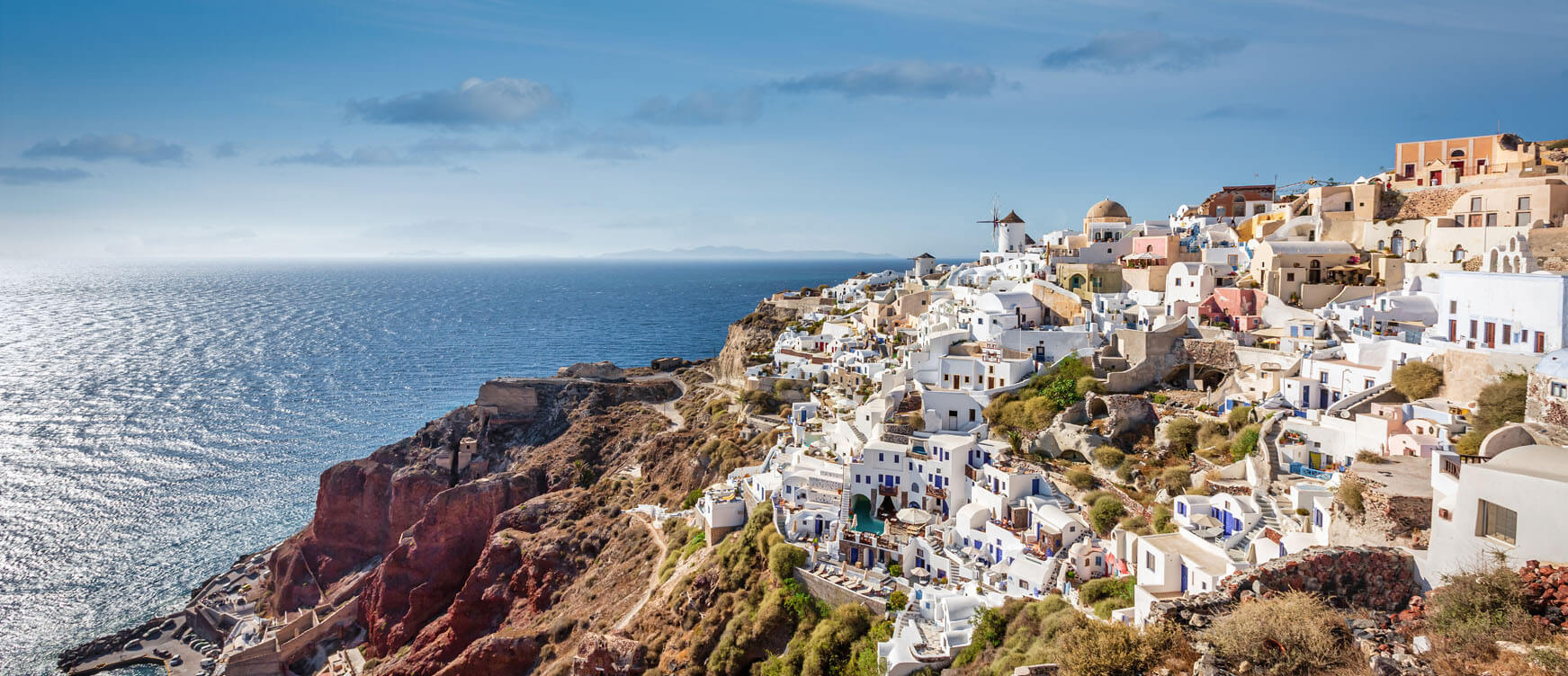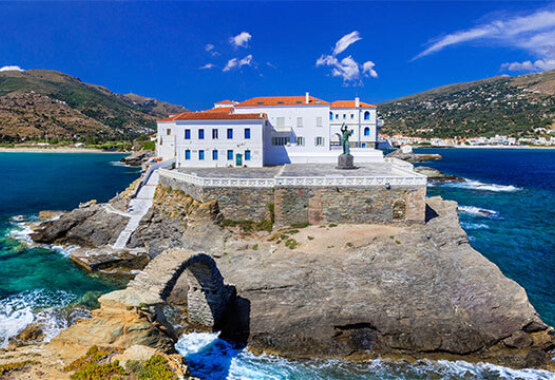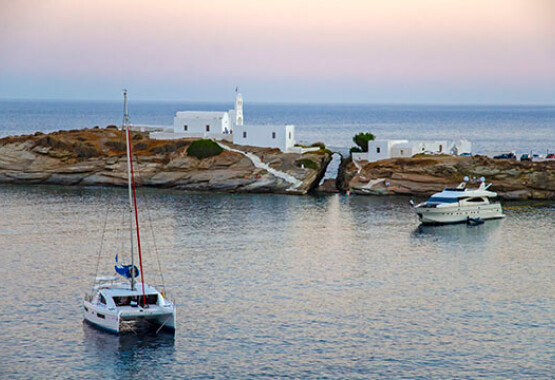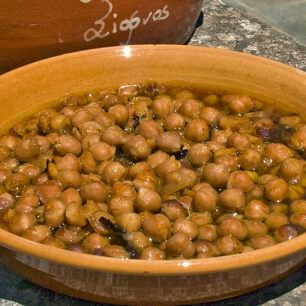

Cyclades
A Dreamscape of Sun-Kissed Islands
The most famous island group in the Aegean Sea comprises some of the most beautiful islands in the world! Gorgeous sandy beaches, architecture in white and blue, traditional lifestyle, folk music, warm, hospitable people and barren landscapes with isolated chapels turn a trip to the Cyclades into a lifetime experience.



Where to go...

Amorgos
Did you know that the 1988 movie “Le Grand Bleu” with Jean Reno was shot on the island of Amorgos, at the south eastern edge of the Cyclades? Parts of the island reach a considerable height above sea level, offering superb views of the sea. Amorgos is one of the most impressive Cycladic islands, boasting marvellous beaches with azure waters, gorgeous caves, ideal spots for diving, scenic bays and ancient footpaths leading through its steep rocky terrain…
Inhabited since the Early Cycladic Era, as indicated by archaeological finds brought to light in the area, Amorgos has a long cultural history and tradition. Step off the beaten track and visit an island that has preserved its traditional colour, where the locals welcome you with a smile on their face and make you feel at home!

Anafi
The island of Anafi is a pristine destination with beautiful beaches with crystal clear waters. Greek Mythology has it that the island emerged from the bottom of the Aegean sea to give shelter to the Argonauts (a band of heroes in Greek mythology.)
Upon entering the bay of Agios Nikolaos, an amphitheatrical view of Chora unfolds before your eyes. The picture perfect Chora village is built on the ruins of a Venetian castle and has whitewashed dome-roofed houses and narrow stone-paved alleys.This is the image that had once inspired the craftsmen who left their home island in the Cyclades for Athens and built the scenic neighbourhood of “Anafiotika” at the base of the Acropolis Rock, back in 1860-1870.

Andros
Andros, the northernmost island of the Cyclades, has a long maritime tradition. Explore sandy beaches, rocky coastlines, water springs, hills and green plains!
The capital of the island, Chοra (which means “main village”) is home to many famous Greek captains and ship owners; Take a look at the remarkable combination of medieval, neoclassical and island style houses. Walk the village down the flights of stairs, around the public square and its narrow streets, visit some remarkable churches and museums, and take a break in its beautiful shops, cafes and restaurants. Don’t miss the Frankish castle located on an islet across the main island connected with an arched stone bridge dating back to the 13th century.

Antiparos
The islet of Antiparos, lying southwest of Paros, is ideal for a relaxed and serene holiday and can easily be reached from Pounda or Parikia by boat. The ancient name of Antiparos was Oliaros. A major Neolithic settlement has been unearthed at the neighbouring islet of Saliagos and it is considered to be the oldest in Cyclades.
Hora (Town) of Antiparos has been built around a 15th century Venetian castle. The stone-paved streets, the whitewashed alleys, the houses decorated with thriving pink and purple bougainvilleas and the central square with its shadowy eucalyptus trees create an enchanting atmosphere.

Delos
The entire island is designated as an archaeological site, to be precise, a UNESCO world heritage site. It’s an ark of history, floating lazily on the waters of the Aegean Sea, just a few miles away from cosmopolitan Mykonos. It’s a chance to walk around the revival of the glory of the Greek civilisation. It’s the head priest of the Cyclades, the birthplace of the immortals. It’s Delos.
In the ancient times, the myth of god Apollo, god of light, and goddess Artemis having been born there rendered the island sacred: no mortal would ever be allowed to be born on its land. But, a cradle of gods as the island has been, no mortals would ever be allowed to die on it either. So, apart from it being a conspicuous religious and economic centre, the island had also been exclusive in that: even during the years of peak of the Delian Alliance, women on the brink of childbirth and people close to dying would be carried to the neighbouring island of Rineia. The whole of the known world of that age was aware of the sacredness of the island and of its uniqueness.

Donousa
The northernmost island of the Small Eastern Cyclades is located east of the island of Naxos and north of Amorgos. Donousa was named after Dionysus, the ancient Greek God of wine who offered Ariadne a hiding place on the island from Theseus.
The island’s capital, port and centre of attention is Stavros but make sure to visit the picturesque villages of Mersini, Haravgi and Kalotaritissa. The 13.65 sq. km island is great for hiking among the thick scent of wild Greek herbs which fill the air. Donousa’s land has plenty of coves where you can relax on some magnificent sandy beaches. If you want to get away from it all and enjoy peaceful holidays, Donoussa is the ideal choice for you!

Folegandros
One of the westerly Cyclades Islands, Folegandros is a place that will steal your heart away the moment you set foot on it. Stroll along the stone-paved streets of Chora and the alleys in the Castle, reach the top of Panagia Rock and enjoy the panoramic view of the Aegean Sea, go swimming in secluded or busy beaches, and admire the local traditional architecture of its villages: these are all part of a breathtaking setting - the ideal one for your holidays - that will place Folegandros on your must-visit list, more than once in your life.
During your walks in the neighbourhoods, you will be impressed by the contrast of the vivid-coloured doors and windows of houses against their bright white walls. The stone-paved streets will lead your footsteps to picturesque squares shaded by tall plane trees. There, under the thick canopy of leaves, you will find the perfect spot to sit and rest for a while.
In the summer, starting at dusk time, the local tavernas in Chora get busy serving tasty local dishes, such as matsata (a local type of pasta), souroto cheese (a white soft spreadable cheese with a peppery flavour), and various pies. After dinner, try the traditional sweets prepared in Chora’s pastry shops and then enjoy a night out in the local bars while drinking rakomelo (a mix of honey with a strong distilled alcoholic drink). The atmosphere gets livelier as the night moves on!

Ios
The island of Ios, or Nios as locals call it, is a charming Cycladic island and renowned among the young for its vivid nightlife. It is located between Santorini, Paros and Naxos islands and offers a plethora of lovely bays and beaches.
The sights you shouldn’t miss out on are the lighthouse at the port entrance as well as the open air theatre “Odysseas Elytis”, where lots of events take place during summer.

Irakleia
Irakleia is the largest and westernmost island in the Minor Cyclades island group, a charming destination in the heart of the Aegean Archipelago, which you must absolutely add to your travelling experiences.
If holidays for you mean a chance to live in pristine natural surroundings, enjoy a slow pace of life, and relaxation, then we’d like to recommend this peaceful location and give you a couple of suggestions to try when you get there.

Kea (or Tzia)
The island of Kea (aka Tzia) is a famous and charming Cycladic island with age-old traditions and interesting history. Its landscape will catch your attention with its green fields, high hills, vineyards, olive groves, ravines, coves and secluded beaches. Visit the largest oak forest in the Cyclades and keep an eye out for the rich bird fauna. Explore its numerous caves (Trypospilies Cave at Kalamos, Agios Timotheos Cave, and Agios Panteleimonas Cave) and the mining area at Orkou. Follow the 81 km paths and discover four ancient city-states of the island (Ioulida - Karthaia - Korissia - Poieessa).
Kea is a famous sailing destination mainly due to its proximity to Attica. Its waters are great for divers as a large number of shipwrecks reside on the sea bottom.
It’s only a 1-hour trip from Lavrio port, Attica.

Kimolos
This tiny yet beautiful island lies in the western part of the Cyclades next to Milos. Possessing a volcanic soil and a unique variety of minerals, its chalk mining past is from where its name derives (kimolia means chalk in Greek). The island is famous for its fantastic sandy or pebbly beaches and coves.
There’s a sheer resemblance to the rest of the Cycladic islands; white houses and cobbled-stone alleys, breathtaking beaches, a Chora Village and hospitable locals!

Koufonisia
Koufonisia is the name of two little islands in the Lesser Eastern Cyclades: Ano Koufonisi and Kato Koufonisi are separated from each other by a 200 m. wide narrow strait. Nearby Naxos Island is located east, Amorgos is to be found west, as well as deserted Keros Island, which is a protected archaeological site where great ancient artefacts were unearthed, dated to the Cycladic Civilisation Period (a Bronze Age civilisation which flourished οn the Aegean Islands).
Ano [or Pano] Koufonisi (meaning Upper Koufonisi) is the only populated island of the two. It is a destination preferred by those who wish to relax on their holidays, in a place with golden-coloured sandy beaches sheltered from the wind, small natural seawater pools with turquoise waters, enchanting natural surroundings, traditional feasting - the local way - and oh-so-fresh fish & seafood dishes. Leave your worries behind and visit this picture-perfect spot of land in the Lesser (or Small) Cyclades, that covers a mere 5.7 sq.km surface. You can explore the entire island on foot, by bicycle or by boat in just 3 hours.
The locals love their festivals. On St. George’s feast day, panigyras [a person who carries the icon of the saint] takes St. George’s icon on a tour around the island, while local boats follow him along the coastline, in honour of the saint. The ‘fisherman’s festival’ takes place on June 24th, where delicious kakavia soup is served (prepared with a variety of small freshly netted fish). The feast of the Dormition of the Mother of God takes place on August 15th and islanders visit Kato Koufonisi for the religious festival in honour of the Holy Virgin.

Kythnos
Despite its proximity to Attica’s coast, Kythnos is one of the lesser-known islands in the Cyclades. The southern part is practically uninhabited, and in the north you will find Merichas (where the island harbour is located), Chora or Mesaria (the island capital), Loutra and Dryopida.
Kythnos wears the standard blue and white colours of the Cyclades, its countryside is dotted with bald hills, dry-stone walls that stretch for kilometres ahead and more than 350 snow white little chapels scattered around the island. It has more than 65 beaches (the majority ending in off-road access tracks) and picturesque villages with the narrow cobbled streets, the white-washed houses, squares, churches and windmills.

Milos
Found in the southwest part of the Cyclades, this island has a handful of singular natural landscapes contributed by volcanic activity; mysterious rock formations, curious soil colours and numerous jaw dropping beaches. Besides having countless unique sights to see around the island, it also is the homeland of the renowned marble statue of Venus of Milo seen today in the Louvre Museum.
Milos’ volcanic past is reflected on the large number of hot springs, caves and geological formations found around the island such as Kanavas, Alykis, Provatas, Pikropigis springs, Papafragas and Sikia Caves, and Kleftiko Cove. The island also has numerous significant archaeological sites such as the early christian catacombs, the Bronze Age settlement of Phylakopi, and interesting museums namely the Mining Museum showcasing Milos’ 11.000 years old mineral history.

Mykonos
Mykonos has been known as the island of the winds, and it’s located in the heart of the Cyclades group. Its fame has spread across the world, as a cosmopolitan and luxurious holiday destination. Bathed in the bright sunlight of the Aegean by day, she dresses in charm and mystery by night, beckoning its visitors to dance and have fun in the beach bars and clubs, go for a shopping spree in luxury stores, visit its art venues, and -in short- have a truly memorable stay!
There are, however, two faces to this island that not many people know of. The first one is the obviously intense, shiny and cosmopolitan aspect of it, and the other one is particularly picturesque, with stone-paved alleys, whitewashed houses, country chapels and windmills, that ooze calm and peace. What makes this island special is that it can cover a variety of demands: you can visit it for its archaeological sites; get to know the local traditions in its picture-perfect villages; and you can explore its amazing beaches, considered by many as the top ones in the Aegean Sea. Chora is quite an impressive and picturesque Cycladic town. You will find top hotels and resorts, designer clothes and goldsmiths boutiques, art galleries, and some of the most famous restaurants and bars in Greece. For a taste of culture and history, take a boat trip to nearby Delos Island; it’s a big and impressive archaeological site.

Naxos
Naxos is the biggest and most fertile island in the group, located right in the centre of it. It offers a host of choices to visitors about activities they can try, as well as other entertainment and relaxation options. The whitewashed Chora town welcomes travellers at its harbour. Portara, Naxos’ most popular landmark, lies on the neighbouring Palatia Islet; it is the marble gate of an unfinished ancient Greek temple dedicated to god Apollo.
Chora’s built landscape is marked by numerous fortified palaces, which date to the island’s Venetian Period, as Naxos was the seat of the Duchy of the Aegean. Make sure you visit the Bazaios Tower, off Sagri village, the Glezos-Crispi Tower in Chora, the Belonia Tower in Galanado and the Della Rocca-Barozzi Tower in Chora.
The diverse, uneven landscape and the size of the island have helped shape a variety of ecosystems. Explore them by following the signposted paths (Chora-Melanes-Chalki; Chalki-Danakos-Apeiranthos; Skado-Apollonas, etc). The route from Apeiranthos to Moutsouna beach goes through the old emery mines, and its beauty is breathtaking: you’ll enjoy the views of the changing nature as you head towards the sea. The mountaineering and mountain biking fans will be happy to explore Mt. Zas (elev. 1004m, the highest mountain on the Cyclades) and Mt Fanari (elev. 908 m). As you climb Mt Zas, don’t miss out on visiting Zas Cave at 628m elevation; you will be impressed by its stalagmites. In ancient times, this location was a place of worship for Zeus, the father of the Olympian gods. On the left side of the cave’s entrance, you will see the tiny country chapel of Zoodochos Pigi (Our Lady).
Naxos is an island with a rich cultural activity. Traditional festivals and other cultural events take place during the summer and in September, such as the Naxos Festival in Bazaios Tower, and Dionysia, which includes a variety of art exhibitions, concerts and theatre shows - among other events, organised under the auspices of the Naxos Municipality. The last celebrations to take place are the Wine Festival and the Fisherman’s Festival, in September.

Paros
High on the list of top Greek holiday destinations, Paros Ιsland welcomes its visitors at the centre of the Cyclades Islands and invites them to explore its beauty, the lovely beaches with crystal-clear waters and some pretty impressive landscapes.
Paros was famous in antiquity for its white marble quarries; the so-called ‘Parian marble’ was highly sought-after for its top quality, for use in architecture and sculpture. Some of the masterpieces of ancient Greek sculpture were made with this pure white, translucent material. The statues of Hermes by Praxiteles, Venus de Milo (i.e. Aphrodite of Milos), Nike [Winged Victory] of Samothrace, Nike of Paionios, and the Caryatids, i.e. the famous daughters [korai] of the Erechtheion, Acropolis, Athens are some of the most popular monuments made with this marble.
Some of the best known sculptors, painters and poets of ancient Greece come from Paros. The island has been an administrative and commercial hub in the Aegean Sea. Over the course of history it was conquered by the Romans, Byzantines, Franks, Venetians and Ottomans. It has known periods of great prosperity, as shown by the artifacts in its archaeological sites, which you can visit across the island.

Santorini
Santorini, known since ancient times as Thira, is one of the most famous islands in the world. The fact that you can sit in front of the caldera, enjoy local dishes, a drink or a coffee while gazing at the remarkable beauty of an active volcano is priceless!
The island is actually a group of islands consisting of Thira, Thirassia, Aspronissi, Palea and Nea Kameni in the southernmost part of the Cyclades.
Santorini’s volcano is one of the few active volcanoes on Greek and European land The islands that form Santorini came into existence as a result of intensive volcanic activity; twelve huge eruptions occurred, one every 20,000 years approximately, and each violent eruption caused the collapse of the volcano’s central part creating a large crater (caldera). The volcano, however, managed to recreate itself over and over again.

Serifos
Serifos is an island with rugged mining sites, a glorious history, and a special style of its own. Once you are there, you will be impressed by the serenity of the landscape, as your senses get attuned to its beauty. The land is made of iron and granite, making Serifos the rockiest island in the Cyclades. It may be an arid place, but it boasts some of the most beautiful beaches found on the Aegean Sea islands.
Serifos’ rugged terrain is the reason for its large variety of beaches. Rocky and pebbly or gold-coloured sands are all washed by crystal-clear deep blue waters. You can access most of them by car, while other locations you can reach through paths or by boat. The island’s pride is Psili Ammos, which has received an award as the top beach among the twenty best beaches in Europe.
The island villages have been built the traditional way, following the local architectural style; you’ll see white-washed little houses with blue-coloured frames on their windows that add to the beauty of the natural surroundings. Serifos is not far from Athens - only two and a half hours by high-speed ferry and about four by conventional ferry. It’s a popular destination for many people and it has fans who visit it every year, either for the weekend or for a longer stay. Serifos is often the choice for those who want a laid-back holiday, but there are also plenty of outdoor activities for you to try here; hiking (along sign-posted paths), climbing, mountain biking, and scuba-diving.

Sifnos
Sifnos is an island of exquisite flavours, time-honoured customs and traditional villages. Its numerous chapels, windmills, lovely beaches, crystal clear waters and leisurely pace of life makes this destination ideal to explore. Located in the southwest part of the Cyclades island group, Sifnos is popular for its architecture, local delicacies, pottery and ceramic art as well as its nightlife during summer.
Throughout antiquity the island went through a period of prosperity as a result of its gold and silver mining, and its local quarries that extracted stones such as sandstone, granite and limestone.
Native to Sifnos island are renowned poets such as Ioannis Gryparis, Kleanthis Triantafyllou (or Rampagas), Aristomenis Provelegios, as well as the award winning chef Tselementés.

Sikinos
Sikinos is a relatively small island of the Cyclades, ideal for a quiet holiday, for relaxing walks in scenic locations and for swimming in clean waters, away from the crowds.
Escape from everyday stress and anxiety on this small island, located between Ios and Folegandros. Sikinos is a typically Cycladic island, with terraces, low stone fences and numerable chapels dotting a scenery bathed by the wonderful green and blue waters of the Aegean.
Its landscape does not have a lot of green and the ground is stony. Characteristic of the island is the steep cliff which is located at the northwest part of the island, where Chora is built.

Syros
Syros Island is a fascinating mix of Venetian Catholic style, architecture & traditions and eastern Greek culture, a place with a distinctive charm and a very long history that dates as far back as the Bronze Age’s Cycladic Civilisation. Today, the island is well-known for its rich cultural tradition, which includes the events that take place in Ermoupoli, the island’s capital town, such as the International Classical Music Festival of Cyclades, the ANIMASYROS International Animation Festival, and the Ermoupoleia Cultural Festival. Make the most of what’s on offer and have a truly memorable stay on the island.
The island has a large number of beaches you can enjoy as well as your favourite water sports, and a rich delicious cuisine. The famous halvadopita (a type of nougat pie), loukoumia (small cubes made of a mixture of sugar, water and starch that are offered in a number of flavours), the cold meats louza and maratholoukanika, as well as the PDO cheese San Michali will tempt the most demanding palate.

Tinos
Tinos, dubbed by philosopher Cornelius Castoriadis as the “handmade island,” is one of the rising island destinations in the Cyclades. An ideal destination for nature lovers, architecture and art aficionados or gastronomy enthusiasts! Tinos is the homeland of great Greek artists of marble carving such as Gyzis, Lytras, Chalepas, Filippotis and Sochos. These artists were famous for their creations, which raised the island’s marble-carving tradition to new heights.
You will enjoy your jaunts in the beautiful beaches and in the picturesque 40 or so villages, built according to the local traditional architectural style. You will be impressed by its culture and tasty cooking, as well as by the locals’ way of life.
The Dazzling Light of the Cyclades
The name “Cyclades” refers to the islands forming a circle (the name in English means: “circular islands”) around the sacred island of Delos. According to the Greek mythology, Poseidon, God of the sea, furious at the Cyclades nymphs turned them into islands.
Let your dream come true in one of the following islands:

Local Dishes
VIEW ALLTips for your Trips
VIEW ALL
An escape to nearby Cyclades
It will only take you a few sailing hours from the ports of Attica (Piraeus or Rafina) to get to them: they are the charming “nearby Cyclades”, the ideal Aegean islands for weekend escapes and island hopping.

Sailing through the Cyclades
The journey through the marvellous islands of the Cyclades is illuminated by the blue and white colours of the Aegean. According to the ancient myth, it is Poseidon, god of the sea...

The day of Virgin Mary

Laid Back Islands

Cultural tour on Paros
Paros is by size the third island of the Cyclades group, combining natural beauty, culture and fun. The visitor can start his tour from Paroikia’s harbour, have some time to relax in the nice little coffee-shops...




